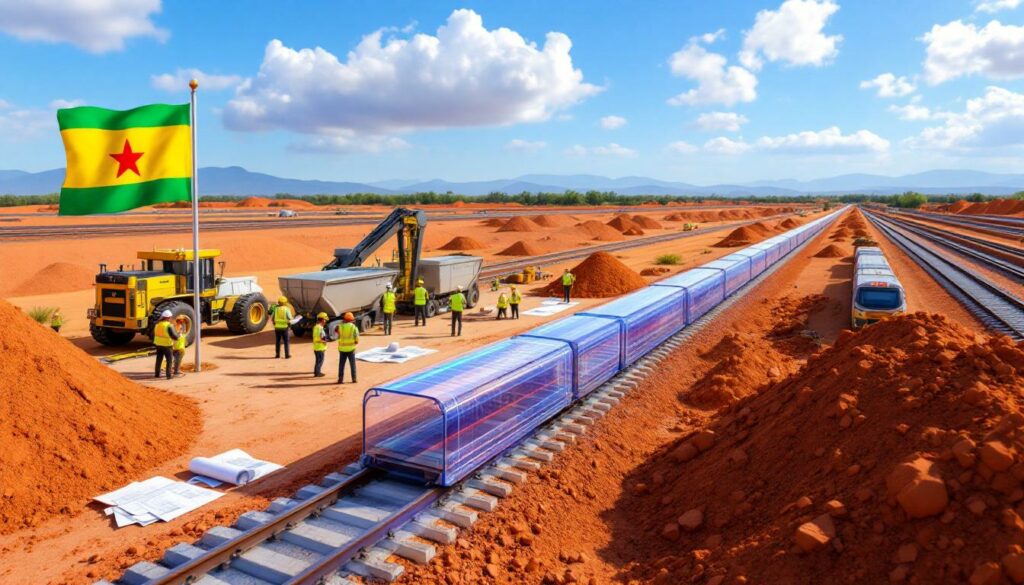Canyon Resources Begins Rail Facility Construction at Makor: A Major Milestone for Cameroon's Bauxite Industry
The construction of rail facility at Makor in Cameroon represents a transformative moment for Canyon Resources and the nation's mining sector. As the company breaks ground on this critical infrastructure project, stakeholders from government officials to investors are taking notice of what this development means for Cameroon's emergence as a significant player in the global bauxite market.
What is the Makor Rail Facility and Why is it Important?
The Makor Inland Rail Facility (IRF) serves as the backbone of Canyon Resources' ambitious export supply chain for their flagship Minim Martap bauxite project. This strategic infrastructure development will enable the company to establish a reliable, efficient logistics corridor for transporting high-grade bauxite from mine to market.
According to Mining Weekly (July 2025), "The IRF is a key piece of infrastructure that will underpin the export supply chain for the Minim Martap bauxite project." This facility represents more than just a transportation hub—it's the critical connection point that will allow Cameroon to capitalize on its rich mineral resources.
The IRF will function as the vital link between mine-site operations and Cameroon's existing rail network, creating an integrated logistics solution that transforms raw bauxite deposits into an exportable commodity. By establishing this crucial infrastructure, Canyon Resources is addressing one of the primary challenges facing African mining operations: reliable transportation infrastructure.
Technical Significance
From a technical perspective, the Makor facility represents a significant engineering achievement designed to handle the specific requirements of bauxite transport. The facility must manage the loading and unloading of this heavy, abrasive material while maintaining efficiency and minimizing environmental impact.
The IRF's strategic location was carefully selected to optimize the balance between proximity to mining operations and access to existing rail infrastructure, demonstrating Canyon's comprehensive approach to project planning.
How Quickly Did Canyon Resources Begin Construction?
Canyon Resources has demonstrated remarkable efficiency in launching construction of the Makor IRF. According to Mining Weekly (2025), "Construction of the IRF has begun just months after the company received approval from the Cameroon government for the site location, demonstrating its commitment to fast-tracking development."
This accelerated timeline highlights Canyon's strategic focus on bringing the Minim Martap project online with minimal delays. The groundbreaking ceremony, held in mid-July 2025, occurred only months after receiving governmental approval earlier in 2025.
Timeline of Key Developments:
- Government approval for site location: Early 2025
- Construction commencement: July 2025
- Projected production start: Early 2026
- First shipment target: First half of 2026
This rapid progression from approval to construction demonstrates Canyon's operational efficiency and the strong governmental support behind the project. The company's ability to navigate Cameroon's regulatory landscape and quickly mobilize resources for construction speaks to both its project management capabilities and the priority status of the Minim Martap development.
What Other Infrastructure Developments Are Underway?
The construction of rail facility at Makor in Cameroon is just one component of a comprehensive infrastructure development strategy. Canyon Resources is simultaneously pursuing multiple infrastructure improvements to create an end-to-end logistics solution.
Most notably, the company has initiated significant upgrades to the ore haulage access road connecting the Minim Martap project to the rail facility. This dual-focus approach ensures the entire logistics chain will be ready for operations once mining begins.
As Mark Hohnen, Executive Chairman of Canyon Resources, explained, "The ore haulage access road and IRF will allow the company to safely and cost-effectively transship bauxite from the mine to the Port of Douala, from where it will export its product to growing global markets" (Mining Weekly, 2025).
Infrastructure Components Under Development:
- Inland Rail Facility at Makor: The central hub for transferring bauxite from road to rail
- Ore haulage access road improvements: Critical for efficient mine-to-facility transport
- Rail infrastructure engineering: Set to begin shortly after IRF construction commencement
- Port facilities at Douala: Planning underway for export terminal capabilities
This comprehensive approach to infrastructure development demonstrates Canyon's understanding that successful mining operations require integrated logistics solutions. By developing each component in parallel, the company is working to eliminate potential bottlenecks in the export process.
Who Attended the Groundbreaking Ceremony?
The groundbreaking ceremony for the Makor IRF attracted a diverse group of stakeholders, highlighting the project's significance to multiple constituencies. The attendance of high-ranking officials underscores the importance of this development to Cameroon's economic future.
According to Mining Weekly (2025), the ceremony was attended by:
- Senior Cameroon government officials
- Local community representatives
- Canyon Resources Executive Chairman Mark Hohnen
- Representatives from cornerstone investor Eagle Eye Asset Holdings
The presence of senior government officials signals strong governmental support for the project, while community representatives' attendance suggests local engagement and acceptance. The involvement of Eagle Eye Asset Holdings representatives demonstrates investor confidence in the project's viability.
Symbolic Significance
Mark Hohnen captured the ceremony's importance, stating, "This is a great moment for our team and our very supportive stakeholders in Cameroon" (Mining Weekly, 2025). The gathering represented more than just the start of construction—it symbolized the collaborative partnership between Canyon Resources, the Cameroon government, local communities, and international investors.
This broad stakeholder representation demonstrates how the construction of rail facility at Makor in Cameroon has galvanized support across multiple sectors, creating a coalition of interests aligned behind the project's success.
What Is the Strategic Importance of the Rail Facility?
The Makor IRF represents a crucial link in Canyon's export logistics chain, enabling the company to establish Cameroon as a significant player in the global bauxite industry. The facility's strategic value extends beyond simple transportation infrastructure.
According to Executive Chairman Mark Hohnen, "The ore haulage access road and IRF will allow the company to safely and cost-effectively transship bauxite from the mine to the Port of Douala, from where it will export its product to growing global markets" (Morningstar, 2025).
This integrated approach to logistics offers several strategic advantages:
- Cost-effectiveness: By optimizing the transfer between road and rail transport, the IRF minimizes logistics costs that often make African mining operations uncompetitive
- Safety improvements: Purpose-built facilities reduce handling risks and improve worker safety
- Supply chain resilience: Creating dedicated infrastructure reduces dependence on shared transportation resources
- Market access: Efficient connection to Douala port opens global markets for Cameroon's bauxite
Economic Impact Considerations
The construction of rail facility at Makor in Cameroon extends beyond Canyon Resources' corporate interests. The development promises significant bauxite project benefits:
- Job creation: Both during construction and operation phases
- Skills development: Training local workforce in modern logistics operations
- Regional economic development: Infrastructure improvements benefit multiple sectors
- Export revenue: Increased mineral exports strengthen Cameroon's balance of trade
The facility serves as a demonstration of how strategic infrastructure investments can unlock natural resource potential that would otherwise remain economically unviable. By addressing the transportation bottleneck, Canyon Resources is creating value that extends throughout Cameroon's economy.
What Does This Mean for Canyon Resources' Future?
The commencement of IRF construction represents a pivotal moment in Canyon Resources' corporate trajectory. This milestone marks the company's transition from exploration and planning to implementation and production.
Mark Hohnen expressed this sentiment clearly: "The future of Canyon is very exciting and I look forward to executing on our strategic plans and becoming the next major ASX-listed bauxite producer" (Mining Weekly, 2025).
The development timeline suggests Canyon is on track to achieve several critical business objectives:
- Production commencement: Early 2026
- First shipments: First half of 2026
- Market position: Establishment as a significant ASX-listed bauxite producer
Strategic Positioning
The construction of rail facility at Makor in Cameroon positions Canyon Resources to capitalize on growing global demand for high-quality bauxite. The company's focus on developing not just mining operations but integrated logistics infrastructure demonstrates a sophisticated understanding of what's required to succeed in the competitive global minerals market.
By controlling more of the value chain through infrastructure development, Canyon is potentially reducing operational risks while increasing its ability to deliver consistent product quality and reliability—factors that are increasingly important to aluminum producers seeking stable supply partnerships.
How Does This Project Fit into the Global Bauxite Market?
The Minim Martap project's advancement comes at a strategic time in the global bauxite and aluminum industry. Worldwide aluminum demand continues to demonstrate resilience and growth across multiple sectors.
Note: The following market analysis is based on industry trends and should be considered in the context of market volatility. Specific data on Canyon's market positioning should be verified through their official investor communications.
Bauxite, as the primary ore for aluminum production, remains essential for industries including:
- Construction: Aluminum's lightweight, corrosion-resistant properties make it ideal for modern building methods
- Transportation: The automotive and aerospace industries increasingly utilize aluminum to reduce weight and improve fuel efficiency
- Electrical infrastructure: Aluminum's conductivity makes it crucial for power transmission networks
- Renewable energy: Solar mounting systems, wind turbine components, and energy storage systems utilize aluminum
- Consumer goods: From packaging to electronics, aluminum remains a versatile material with growing applications
Quality Positioning
The Minim Martap project reportedly features high-grade bauxite deposits, potentially allowing Canyon Resources to position its product as a premium offering in the market. High-grade bauxite typically results in more efficient aluminum production with lower processing costs and reduced environmental impact.
By developing efficient export infrastructure alongside its mining operations, Canyon Resources is addressing one of the key challenges that has historically limited African bauxite producers' competitiveness in global markets: transportation costs. This approach aligns with broader trends in South Africa beneficiation strategies across the continent.
What Are the Next Steps for the Project?
With the construction of rail facility at Makor in Cameroon now underway, Canyon Resources has established clear next steps to maintain momentum toward production. The company's systematic approach demonstrates comprehensive planning for bringing the Minim Martap project online efficiently.
Based on the information available, Canyon Resources will focus on:
- Completing IRF construction on schedule: Ensuring the facility is operational when needed
- Finalizing engineering work for rail and port infrastructure: Creating the complete logistics chain
- Continuing mine site preparation: Developing extraction capabilities in parallel with transport infrastructure
- Securing additional partnerships and agreements: Establishing commercial relationships for operations
- Preparing for production commencement: Target of early 2026
This phased approach allows the company to manage the complex interdependencies of developing a major mining operation while maintaining control over critical timelines.
Critical Path Management
The simultaneous development of the IRF and ore haulage road demonstrates Canyon's understanding of critical path management. By addressing these two infrastructure components in parallel, the company increases the likelihood of meeting its ambitious timeline for first production and shipment in 2026.
The focus on completing the IRF before moving to rail and port engineering work suggests a strategic sequencing of infrastructure development, potentially allowing for the most efficient allocation of resources and capital.
FAQ: Canyon Resources' Makor Rail Facility
How will the rail facility impact local communities?
The construction of rail facility at Makor in Cameroon is expected to create both direct and indirect employment opportunities for local communities. Beyond job creation, the infrastructure improvements may enhance regional connectivity and economic activity.
Disclaimer: Community impact assessments should be evaluated through Canyon's sustainability reporting and independent studies as they become available.
What is the significance of Eagle Eye Asset Holdings' involvement?
As Canyon's cornerstone investor, Eagle Eye Asset Holdings has provided crucial financial backing for the Minim Martap project. Their representatives' presence at the groundbreaking ceremony indicates ongoing support and confidence in the project's development.
The partnership demonstrates how international capital can help activate Africa's natural resources when paired with strong local government support and appropriate infrastructure development.
How does this development compare to other bauxite projects in Africa?
The Minim Martap project is positioning itself as a significant bauxite operation within Africa, with the Makor rail facility enabling efficient access to global markets via the Port of Douala. The project's scale and approach shares similarities with the Arrow Minerals bauxite project in other parts of the continent.
Note: Comparative analysis with other African bauxite projects should be based on production volumes, grades, and logistics efficiency metrics as they become available through Canyon's official communications.
What environmental considerations are being addressed in the construction?
While specific environmental measures weren't detailed in the available information, major mining infrastructure projects typically require comprehensive environmental impact assessments and mitigation strategies. The implementation of modern mining electrification technologies may be part of the project's environmental management approach.
Disclaimer: Investors and stakeholders should refer to Canyon's environmental reporting and regulatory filings for specific details on environmental management practices.
What is the estimated capacity of the rail facility?
The available information doesn't specify capacity figures for the Makor IRF. However, the facility is designed to handle the production volume from the Minim Martap project for export through the Port of Douala.
Note: Capacity specifications would typically be included in technical feasibility studies and investor presentations, which should be consulted for precise figures.
The Road Ahead for Canyon Resources
The construction of rail facility at Makor in Cameroon represents just the beginning of Canyon Resources' journey toward becoming a significant bauxite producer. As the company progresses through its development timeline, stakeholders will be watching closely for continued execution against planned milestones.
The project's success will depend not only on completing infrastructure development on schedule but also on maintaining strong relationships with the Cameroon government, local communities, and investment partners. Canyon Resources appears well-positioned with support from multiple stakeholders as demonstrated at the groundbreaking ceremony.
For those tracking developments in African mining, the Minim Martap project offers an instructive case study in how strategic infrastructure investments can unlock natural resource potential and create value for both companies and host nations. As the project advances, it may provide valuable 2025 investment insights for those considering exposure to the mining and infrastructure sectors.
Disclaimer: This article contains forward-looking statements regarding project timelines and outcomes. Actual results may vary based on numerous factors including market conditions, regulatory processes, and operational developments. Readers should consult Canyon Resources' official communications for the most current information.
Want to Stay Ahead of Major ASX Mining Discoveries?
Discovery Alert's proprietary Discovery IQ model instantly notifies investors of significant mineral discoveries on the ASX, transforming complex data into actionable investment opportunities before the broader market reacts. Explore how historic discoveries have generated substantial returns by visiting Discovery Alert's dedicated discoveries page.




